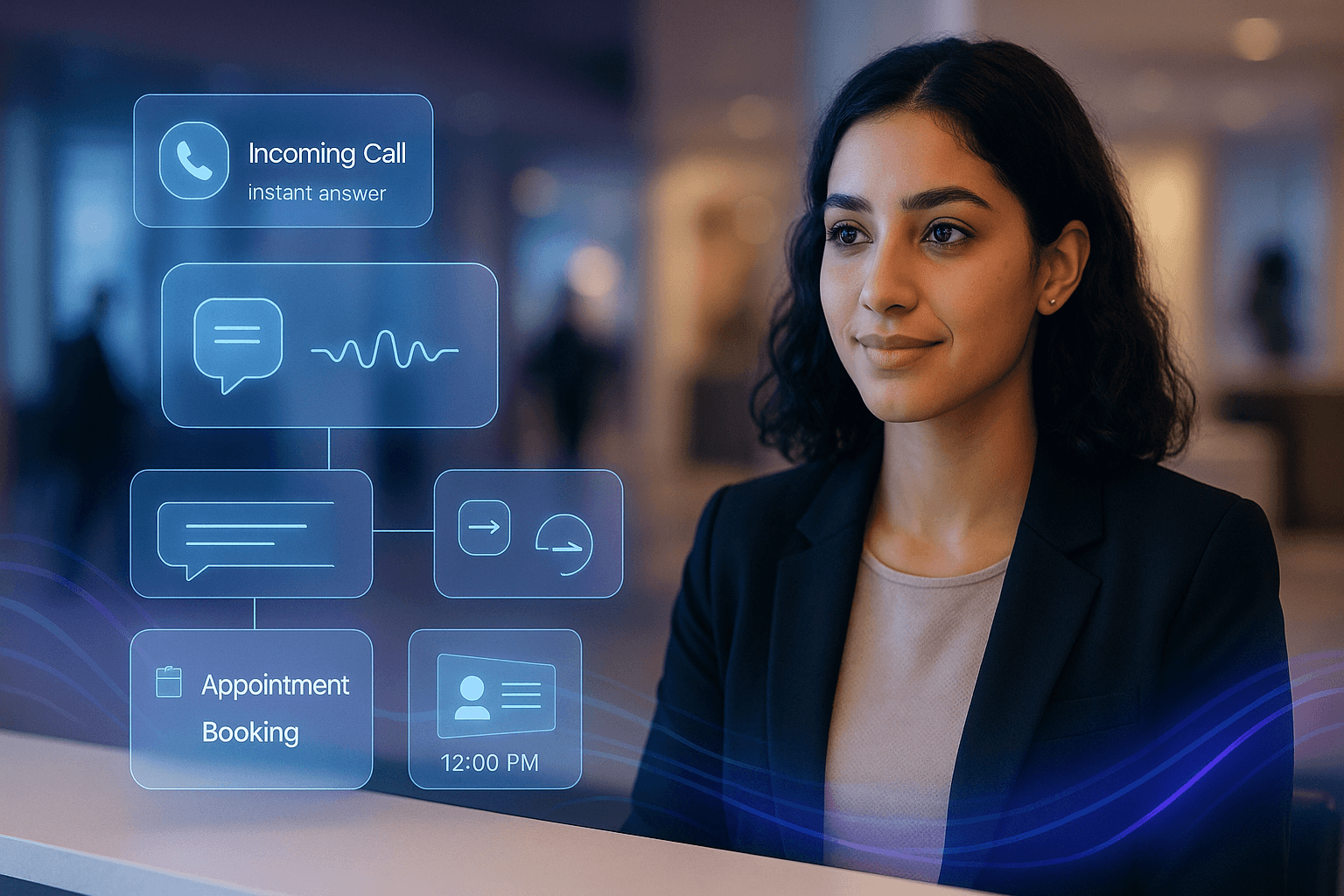Nov 2, 2025
Voice AI Agents vs. Chatbots: Which Is Better for Home Service Businesses?
Voice AI or chatbots for home services? Discover which automation technology handles phone calls, emergencies & customer interactions better for contractors.
5
min read
Voice AI Technology Explained
When your AC breaks on a 95-degree day, does a homeowner want to type messages back and forth with a chatbot—or do they want to call someone who can help immediately?
For home service contractors, this isn't a philosophical question. It's a business-critical decision that affects how you capture leads, serve customers, and grow revenue. Both conversational AI for contractors and text-based chatbots promise automation and efficiency, but they solve fundamentally different problems in fundamentally different ways.
Let's break down the real differences between voice AI and chatbots so you can understand which technology actually fits your home services business—or whether you need both.
Why Phone Calls Still Dominate Home Services
Before diving into technology comparisons, let's establish a fundamental truth: when people need a contractor, they overwhelmingly prefer calling over any other communication method.
Industry research consistently shows that phone calls generate conversion rates three to five times higher than web forms or chat interactions for home services. There's a simple reason—urgency and complexity. When someone's toilet is overflowing or their heat isn't working in winter, they don't want to wait for chat responses. They need immediate answers and fast scheduling.
The numbers back this up. Studies indicate that approximately 75-80% of home service inquiries still come through phone calls, not website forms or chat windows. This phone preference isn't just about older demographics either—millennials and Gen Z customers call contractors when they need help, even though they text for almost everything else in their lives.
Why? Because home service problems are urgent, expensive, and require nuanced conversation. A customer needs to describe what's happening with their HVAC system, understand pricing, ask follow-up questions, and feel confident they're hiring the right contractor. That's difficult to accomplish through typing.
This phone dominance creates a clear business imperative: if you're going to automate customer interactions, Voice AI for home services directly addresses your highest-volume, highest-value channel. Chatbots address a secondary channel that, while useful, represents a smaller fraction of your lead flow.
How Do Voice AI and Chatbots Handle Emotional Intelligence?
Here's where the difference between voice and text becomes critical for contractors—emotional intelligence and customer experience.
When a homeowner calls about a broken furnace in January, they're not just seeking information. They're stressed, possibly frustrated, and need reassurance that help is coming. Voice AI Agents can detect emotional cues through tone, pacing, and word choice. Advanced systems adjust their response style based on detected stress or urgency, providing empathetic acknowledgment and prioritizing the interaction appropriately.
Text-based chatbots lack this capability entirely. They can't hear the urgency in someone's voice or recognize when a customer is becoming frustrated with the interaction. Everything is processed as neutral text input, missing the emotional context that's crucial for service interactions.
Consider a typical scenario: A customer calls saying their water heater is leaking. A Voice AI Agent can hear the stress in their voice, recognize this as an emergency, expedite scheduling, and communicate with appropriate urgency. A chatbot receives the same information as text and processes it algorithmically without emotional context—potentially treating an emergency the same as a routine maintenance inquiry.
For home services where customer situations range from routine inquiries to genuine emergencies, this emotional intelligence gap matters tremendously. Voice creates connection and trust in ways text simply cannot.
What Are the Best Use Cases for Voice AI?
Voice AI for home services excels in specific scenarios that align with how contractor businesses actually operate:
Inbound Call Handling: This is voice AI's primary strength. When customers call—whether at 2 PM or 2 AM—voice AI answers immediately, gathers information, qualifies the lead, and schedules appointments. For contractors who miss 30-40% of calls during busy periods, this capture rate improvement directly translates to revenue.
Complex Service Explanation: Try explaining the difference between tankless and traditional water heaters in a chat window. It's awkward and time-consuming. Voice conversation allows natural back-and-forth dialogue where the AI can ask clarifying questions, provide detailed explanations, and adapt to the customer's knowledge level in real-time.
Emergency Triage: When a customer calls with an urgent problem, voice AI can quickly assess severity, prioritize based on predefined criteria, and either dispatch immediately or provide interim guidance. This nuanced triage requires conversational flow that text-based systems struggle to provide.
After-Hours Coverage: Phone calls don't stop at 5 PM, but your staff does. Voice AI Agents provide 24/7 phone coverage that sounds professional and helpful, not robotic. Customers calling after hours get the same quality experience as those calling during business hours—something answering services and voicemail can't deliver.
High-Value Lead Qualification: For contractors where average job value ranges from hundreds to thousands of dollars, spending AI resources on thorough phone qualification makes economic sense. Voice AI can ask detailed questions, explain options, and qualify leads more thoroughly than chat interfaces allow.
When Do Chatbots Make Sense for Contractors?
Chatbots aren't useless for home services—they're just better suited for different scenarios than voice AI:
Website FAQ Handling: Simple questions like "What areas do you serve?" or "What are your hours?" can be efficiently handled by text-based chatbots embedded on your website. These don't require voice interaction and let website visitors get quick answers without calling.
Appointment Reminders and Confirmations: Text-based automated messaging works well for sending appointment reminders, confirmation requests, and follow-up communications. Customers expect these interactions via text, and voice calls would actually be more intrusive.
Simple Status Updates: "Where's my technician?" or "What's the status of my estimate?" are questions easily handled through text chatbots that can pull information from your scheduling or CRM system and display it quickly.
Lead Capture When Voice Isn't Preferred: Some customers prefer not to call, especially for non-urgent inquiries. Having a chatbot option lets you capture these leads rather than losing them entirely. However, recognize this represents a smaller portion of your total lead volume.
After-Hours Information Gathering: While voice AI handles after-hours calls, chatbots can complement this by gathering preliminary information from website visitors, then prompting them to either call the voice AI system or leave information for morning follow-up.
The key insight is that chatbots work best for simple, transactional interactions where emotional intelligence isn't required and text communication suffices. They don't replace the need for voice automation in contractor businesses—they supplement it.
What About Hybrid Approaches?
The most sophisticated conversational AI for contractor implementations don't force an either-or choice—they use both technologies strategically.
A hybrid approach might work like this: Your website has a chatbot that handles basic FAQs and lead capture. When a website visitor expresses urgency or wants to discuss a complex problem, the chatbot offers to connect them with your voice AI system via phone call. Meanwhile, inbound calls go directly to voice AI for immediate handling.
After voice AI captures a lead, text-based systems can handle follow-up communications—appointment reminders, technician arrival notifications, and post-service feedback requests. This leverages the strengths of each technology without forcing customers into uncomfortable communication channels.
Some advanced systems even offer voice-to-text transcription, where voice AI conversations are automatically summarized and made available as text in your CRM, combining the conversational advantages of voice with the searchability and documentation benefits of text.
The question isn't whether to use Voice AI Agents or chatbots—it's how to deploy each where they provide maximum value. For most home service contractors, that means voice AI as your primary automation focus (because phone calls dominate your lead flow) with chatbots as a secondary supplement for website interactions and text-based follow-up.
How Do You Decide What Your Business Needs?
Making the right choice between voice AI and chatbots requires honest assessment of your current situation:
Analyze Your Communication Channels: Pull data on how customers currently contact you. If 70-80% of inquiries come via phone (which is typical for home services), voice AI should be your automation priority. If you have significant web traffic with high bounce rates, adding chatbots for website engagement makes sense as a secondary investment.
Identify Your Biggest Pain Points: Are you missing phone calls during busy periods? Voice AI solves that. Do website visitors leave without contacting you? Chatbots might help capture some of those. Do after-hours calls go to voicemail? Voice AI provides 24/7 coverage. The technology you need depends on which problems cost you the most revenue.
Consider Your Service Complexity: Simple services with straightforward pricing can work reasonably well with chatbots. Complex services requiring consultation, explanation, and trust-building need voice AI's conversational capabilities.
Evaluate Customer Demographics: While phone calls dominate across all age groups in home services, certain demographics may be slightly more open to text chat. However, don't overestimate this—even digital natives call contractors when they need help.
Assess Integration Requirements: Both technologies need to integrate with your existing systems (CRM, scheduling, payment processing), but voice AI typically requires more sophisticated integration. Ensure whatever you implement actually connects to your business workflows rather than creating isolated data silos.
For most home service contractors, the data-driven answer is clear: start with Voice AI for home services because that's where most of your customer interactions happen and where automation delivers the highest ROI. Add chatbots later as a complementary tool for website engagement and text-based follow-up if your business size and budget support it.
The worst decision is analysis paralysis that leaves you with neither technology while competitors who've automated are capturing the leads you're missing.
The Bottom Line for Contractors
Voice AI and chatbots aren't competing technologies—they solve different problems. For home service businesses where phone calls dominate customer contact, urgent problems require immediate response, and service complexity demands real conversation, Voice AI Agents deliver the automation that actually moves your revenue needle.
Chatbots have their place for simple website interactions and text-based follow-up, but they can't replace the need for intelligent phone automation in an industry where customers overwhelmingly prefer calling when they need help.
The question isn't which technology is "better" in abstract—it's which technology addresses your business's actual communication patterns and customer preferences. For home service contractors, that answer is usually voice AI first, with chatbots as a potential supplement later.
Ready to discover which solution fits your business? Analyze your current call volume, missed opportunity costs, and customer communication patterns—then choose the technology that addresses your biggest revenue leaks. For most contractors, that means starting with voice AI automation.
Related articles
KI Voicebots als digitale Rezeption
Digitale Rezeption mit KI Voicebots von Leaping AI: Ständige Erreichbarkeit, automatische Terminbuchung und 62% Kostenersparnis. So automatisieren Hotels, Praxen und andere Unternehmen ihre Kommunikation mit dem deutschen Marktführer für Voice AI.
KI Telefonassistenten von Leaping AI - so gehts
Schritt-für-Schritt Anleitung zur Implementierung von KI Telefonassistenten mit Leaping AI. Erfahren Sie, wie Sie in vier Wochen Ihren Kundenservice automatisieren, Kosten sparen und die Kundenzufriedenheit steigern.





